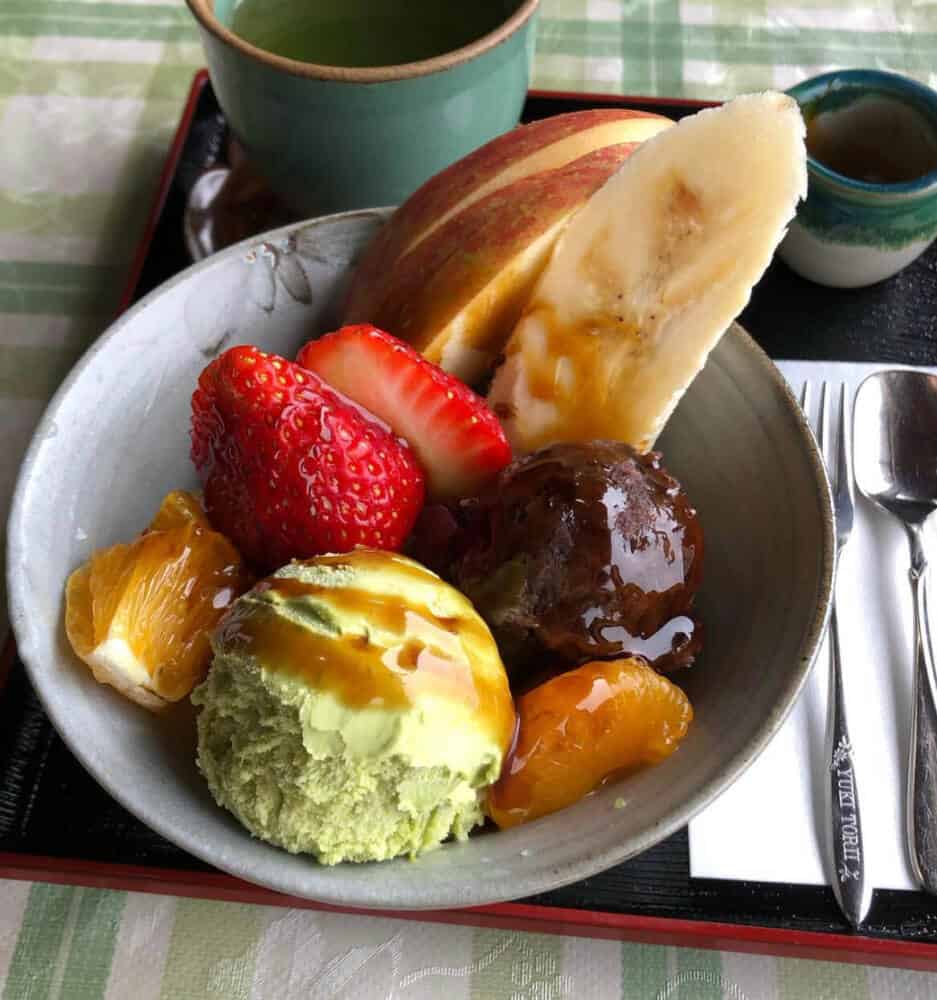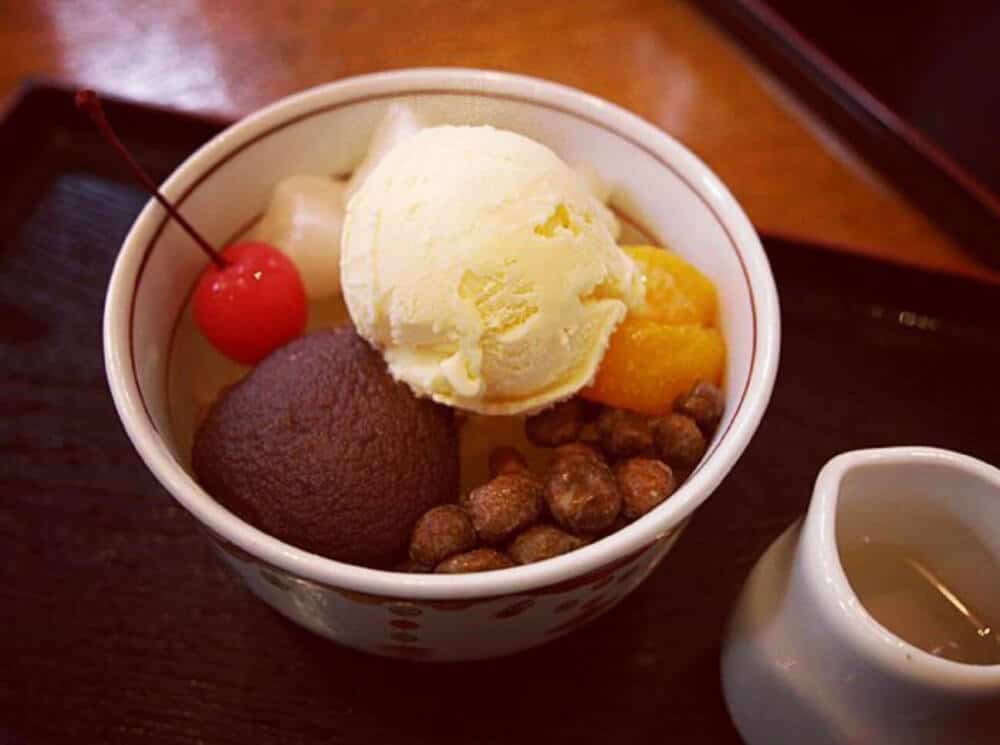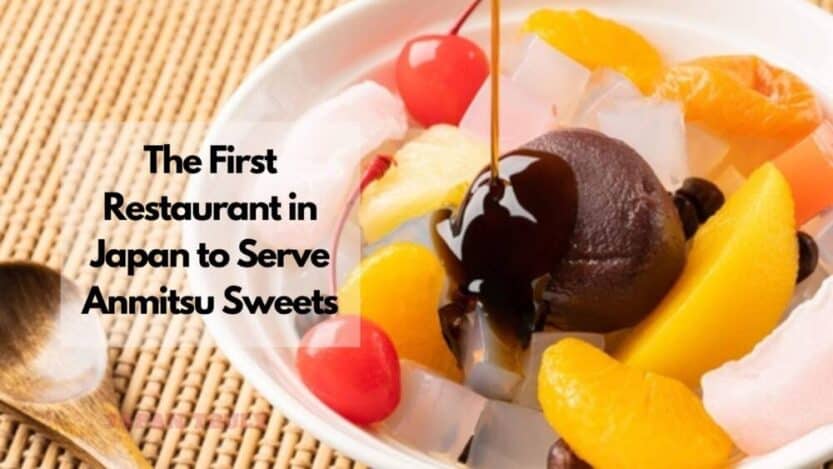Anmitsu, a well-loved traditional Japanese dessert, has been a staple in Japan’s sweet offerings for decades.
The dish combines jelly made from agar-agar (kanten), red bean paste (anko), and a drizzle of brown sugar syrup (kuromitsu). This delectable concoction is often found in confectionery stores and cafes throughout Japan.
In the heart of Tokyo’s Ginza district, there lies a notable establishment that holds the title of anmitsu’s originator: Wakamatsu.
Having opened its doors in 1894, this restaurant is renowned for introducing anmitsu in 1930. Stepping into the modern-day Ginza, one can still indulge in the original anmitsu at Wakamatsu, a testament to its enduring legacy.

Nestled beside a contemporary Prada store, Wakamatsu maintains its traditional aesthetic, complete with a display showcasing their “Original Anmitsu”.
This iconic dessert often pairs its key ingredients with a variety of fruits and sweet beans. During my latest visit, I opted for the cream shiratama anmitsu—a variation featuring vanilla ice cream and soft shiratama mochi dumplings, priced at 1,250 yen.

The presentation of the dish was visually stunning, completed with a slice of yokan—a sweet bean jelly fashioned into a pine tree motif, reflecting Wakamatsu’s namesake which means “young pine.” It’s customary to pour the kuromitsu over the dish before diving in.
My first bite introduced me to the intriguing texture of kanten cubes, quickly followed by their delightful sweetness. I then sampled the harmonious blend of sweet beans paired with the icy vanilla—a flavor profile striking a balance between rich earthiness and creamy sweetness.
Wakamatsu’s anmitsu experience solidifies why this dessert, and the restaurant itself, has stood the test of time. For those who’ve yet to try anmitsu, there’s truly no better place to start than where it all began.
The essentials for a visit to Wakamatsu are as follows:
Visit Wakamatsu: Tokyo’s Dessert Gem
- Location: Core Building 1st floor, 5-8-20 Ginza, Chuo-ku, Tokyo
- Operating Hours: 11 a.m. to 6 p.m.
- Closure Days: Mondays and Tuesdays
- Contact: Website for further details
Please note that photography is credited to SoraNews24. Stay updated with their latest content via social media platforms.
The Origins of Anmitsu in Japanese Gastronomy
Anmitsu, a sweet delight, traces its roots back to the Japanese Edo period. As a form of traditional confectionery, it integrates a variety of ingredients to create a harmoniously sweet reflection of the era. Initially a luxury, it has evolved to become a beloved treat in modern Japan.
Pioneer of Anmitsu Service in Japan
The Tokyo-based restaurant, Wakamatsu of Ginza, is credited with the pioneering service of anmitsu. This establishment broke culinary ground nearly a century ago and continues to serve this iconic dessert today, preserving the tradition Wakamatsu’s culinary legacy.
Key Components of Anmitsu
Anmitsu is crafted with:
- Agar agar (kanten): a gelatin-like substance made from algae
- Sweet adzuki bean paste (anko)
- Dark molasses-like syrup (kuromitsu)
- Various fruits and mochi for garnish
This combination offers a taste that is both sweet and subtly complex.
Impact on the Japanese Gastronomic Scene
Anmitsu is more than a dessert; it’s a cultural icon. It carries the essence of Japanese hospitality and meticulous attention to detail, having influenced the country’s dining culture by demonstrating how traditional sweets can adapt without losing their authenticity.
Anmitsu’s Role in Japanese Traditions
Anmitsu represents a piece of culinary history in Japan. It’s a classic dessert that evokes nostalgia and has withstood the test of time, often served on festive occasions or as a coveted indulgence in Japanese dessert shops.
Significant Historic Japanese Desserts Similar to Anmitsu
Along with anmitsu, Japan is home to other notable desserts that have historical significance:
- Mochi, rice cakes that are a staple in New Year celebrations
- Dorayaki, sweet pancakes filled with red bean paste
- Taiyaki, fish-shaped cakes filled with sweetened red beans
These desserts share anmitsu’s traditional heritage and continue to be an integral part of Japan’s confectionery landscape.
My writing focuses on the various aspects of Japanese lifestyle, from traditional tea ceremonies and flower arrangement to modern fashion trends and pop culture. Through my articles, I aim to share my passion for Japan and provide readers with a glimpse into the rich and diverse world of Japanese culture.
I believe that the key to understanding Japanese lifestyle is to appreciate the balance between tradition and innovation. While Japan has a rich cultural heritage that dates back centuries, it is also a country that is constantly evolving and embracing new ideas and technologies.
Whether you’re interested in learning about the latest fashion trends in Tokyo, or want to explore the ancient art of calligraphy, my writing will take you on a journey through the many facets of Japanese lifestyle. So join me as we explore the beauty and complexity of this fascinating culture together!






